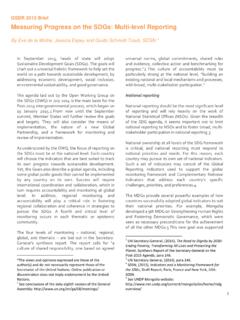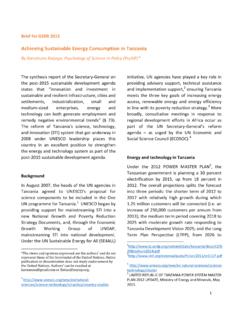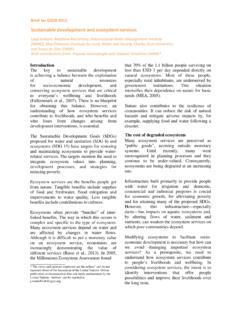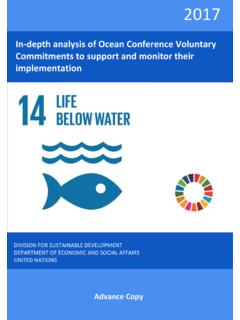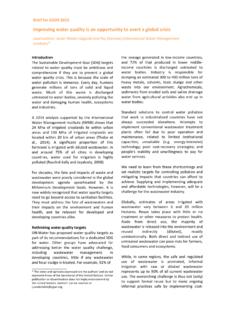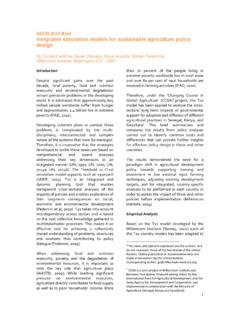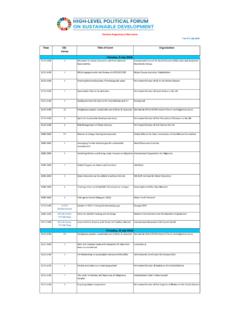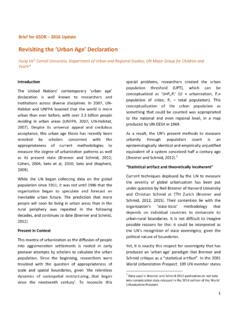Transcription of PROGRESS TOWARD SUSTAINABLE ENERGY
1 PROGRESS . TOWARD . SUSTAINABLE . ENERGY . GLOBAL tracking . FRAMEWORK 2015. KEY FINDINGS. Key findings been moving TOWARD the three objectives. Based on the latest data, it reports PROGRESS on selected indicators over the two- The first SE4 All Global tracking Framework (GTF 2013) es- year tracking period 2010 12 and determines whether move- tablished a consensus-based methodology and identified ment has been fast enough to meet the 2030 goals. concrete indicators for tracking global PROGRESS TOWARD the three SE4 All objectives. One is to ensure universal ac- Overall PROGRESS over the tracking period falls cess to modern ENERGY services. The second is to double substantially short of what is required to attain the SE4 All the global rate of improvement in ENERGY efficiency.
2 And objectives by 2030. the third is to double the share of renewable ENERGY in the global ENERGY mix. GTF 2013 also presented a data plat- Across all dimensions of SUSTAINABLE ENERGY for all . form drawing on national data records for more than 180 whether access, efficiency, or renewables the rate of countries, which together account for more than 95 per- PROGRESS during the 2010 12 tracking period falls sub- cent of the global population. And it documented the his- stantially short of the rate that would be needed to ensure torical evolution of selected indicators over 1990 2010, that the three objectives are met by 2030 (figure 1). Nev- establishing a baseline for charting PROGRESS . ertheless, the 2010 12 tracking period does present some encouraging acceleration in PROGRESS relative to what was GTF 2015 presents an update on how fast the world has observed in prior decades.
3 Been moving TOWARD the goal of SUSTAINABLE ENERGY for all. Efforts must be redoubled to get back on track;. particularly in countries with large access deficits and This second edition of the SE4 All Global tracking Framework high ENERGY consumption whose rate of PROGRESS carries (GTF 2015) provides an update on how fast the world has substantial weight in the global aggregate. Figure 1. How far is the rate of PROGRESS from that required to attain SE4 All? Annual growth rates (%). 8. 6. 4. 2. 0. 2. Universal access Universal access Improvement in Renewable ENERGY share Modern renewable to electricity to non-solid fuels primary ENERGY intensity in total final ENERGY share in ENERGY consumption total final ENERGY consumption PROGRESS 2000 10 PROGRESS 2010 12 Target rate SE4 ALL.
4 Source: World Bank Global Electrification database 2015; IEA, UN, and WDI data (2014); analysis by the International Renewable ENERGY Agency based on IRENA (2014). Note: Figure shows average annual growth rates for access to electricity and non-solid fuels, and compound annual growth rates for renewable ENERGY and ENERGY efficiency. 2 PROGRESS TOWARD SUSTAINABLE ENERGY GLOBAL TR ACKING FR A MEWORK 2015 KEY FINDINGS. although even this represents PROGRESS compared to ear- lier decades. By contrast, access to clean cooking continues to fall behind population leading to negligible PROGRESS overall. The annual growth in access to non-solid fuels during the tracking period was negative percent, comparable to what was registered during the 2000 2010 period, and woefully short of the percent target growth rate re- quired to reach universal access by 2030 (see figure 1).
5 As a result, primary access to non-solid fuels barely rose from 58 percent in 2010 to 59 percent in 2012. This means that only 125 million additional people mainly in urban areas gained first time access to non-solid fuels;. no more than the population of Mexico and falling behind the 138 million population increase that took place over the same period. Overall, the global access deficit barely moved from billion; concentrated in rural areas of Africa ENERGY has a key enabling role in food security and nutrition. and Asia. Out of the 20 countries with the largest access Vanessa Lopes Janik/ World Bank deficit, only 8 succeeded in expanding access to non-solid fuels more rapidly than population growth (figure 2b). There have been notable advances in electrification.
6 Driven primarily by India but PROGRESS in Africa remains Traditional methods for measuring ENERGY access far too slow. significantly underestimate the scale of the challenge. The annual growth in access to electricity during the track- Traditional measures of ENERGY access reported above, ing period reached percent, approaching the target which focus on grid connections, are not able to capture growth rate of percent required to reach universal ac- broader deficiencies in the affordability, reliability and qual- cess by 2030, and certainly much higher than the growth ity of service. This report presents an emerging multi-tier of percent registered over 2000 2010 (see figure 1). approach to access measurement that is able to capture these broader dimensions.
7 As a result, the global electrification rate rose from 83 per- cent in 2010 to 85 percent in 2012. This means that an New evidence from the city of Kinshasa in the Democratic additional 222 million people mainly in urban areas Republic of the Congo shows that whereas traditional gained first time access to electricity; more people than access indicators report 90 percent access to electricity the population of Brazil, and well ahead of the 138 million due to widespread grid connections in the city the multi- population increase that took place over the same period. tier approach rates access at only 30 over 100 due to ex- Overall, the global electricity deficit declined from bil- tensive limitations in hours of service, unscheduled black- lion to billion.
8 Global PROGRESS was driven by significant outs and voltage fluctuations. The reality is that the streets advances in India, where 55 million people gained access of Kinshasa are dark on most nights and that few house- over 2010 12. holds can actually use the electrical appliances they own. In order to advance towards universal access to electric- PROGRESS in reducing global primary ENERGY intensity ity, countries need to expand electrification more rapidly over the tracking period was substantial, though still than demographic growth. Out of the 20 countries with the only two-thirds of the pace needed to reach the SE4 All largest electrification deficit, only 8 succeeded in doing so objective. (figure 2a). For Sub- Saharan Africa as a whole the re- gion with by far the highest access deficit electrification Primary ENERGY intensity the global proxy for ENERGY only just managed to stay abreast of population growth; efficiency, and influenced as well by changes in the 3.
9 Figure 2. High-impact countries, PROGRESS TOWARD targets, 2010 12. a. Access to electricity, b. Access to non-solid fuels, average annual growth rate (%) average annual growth rate (%). Afghanistan Nepal Nigeria Afghanistan Yemen Vietnam Philippines Indonesia India China Bangladesh Congo, DR. Korea, DPR Pakistan Congo, DR India Burkina Faso Korea, DPR. Mozambique Philippines Myanmar Bangladesh Angola Nigeria Uganda Kenya Niger Tanzania Ethiopia Mozambique Malawi Madagascar Tanzania Uganda Kenya Myanmar Madagascar Ethiopia Sudana Sudan a 4 0 4 8 c. ENERGY intensity, d. Modern renewable ENERGY , compound annual growth rate (%) compound annual growth rate (%). Japan Nigeria Indonesia China Germany Korea, Rep. United States United Kingdom South Africa Australia Saudi Arabia Italy United Kingdom Iran France Germany Italy India Canada United States China Canada India Turkey Mexico Spain Australia Brazil Korea, Rep.
10 Saudi Arabia Russian Federation Indonesia Iran Russia Thailand France Nigeria Mexico Brazil Japan 6 4 2 0 2 5 0 5 10 15 20. Source: IEA and UN data. Note: Growth rate calculation involves two parameters population with access and total population of the country. a. Data from Sudan show a very high growth rate in access. This is not shown in the figure as it is due to a lower population in 2012 compared with 2010, resulting from the split with South Sudan. 4 PROGRESS TOWARD SUSTAINABLE ENERGY GLOBAL TR ACKING FR A MEWORK 2015 KEY FINDINGS. structure of the world economy improved by more than equivalent to ENERGY consumption of Pakistan or Thailand percent a year over the tracking period, considerably in 2012. The increment resulted from both an acceleration more than in the base period 1990 2010.
